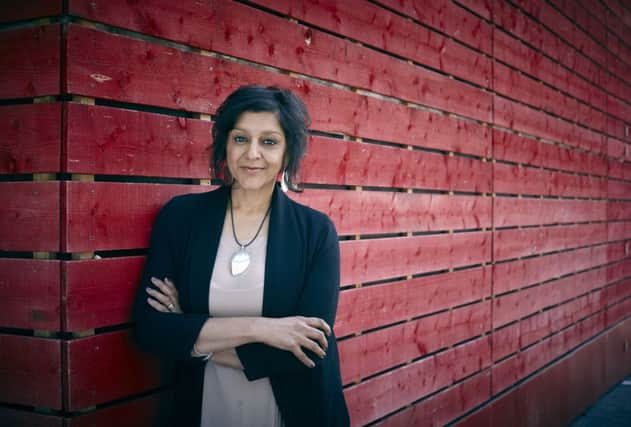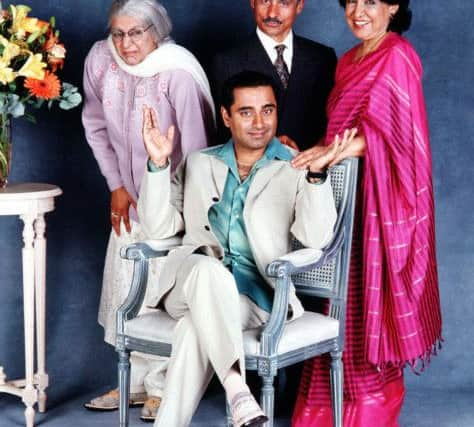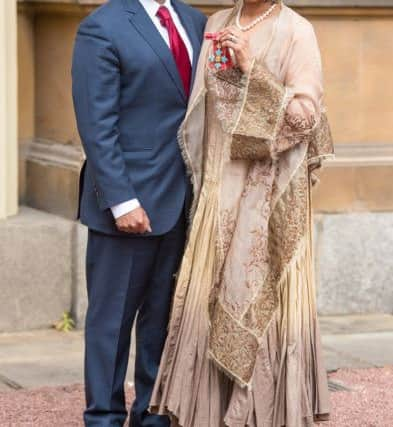Author Meera Syal on what has driven her career


“I never planned to be a writer per se but it was born out of frustration,” she says. “Actors don’t have a lot of power. It’s competitive trying to get on but you keep plugging away. You have to be proactive and creative and the roles you get offered as a woman as you get older are going to start getting less and less. You want to be creative and if that means writing, producing and collaborating, then that’s what you do.”
Syal has turned to her own life and experiences for subject matter and given voice to women whose stories might otherwise have gone untold. Alongside screen and stage work, she’s also penned three novels: Anita and Me (1996), Life Isn’t all Ha Ha Hee Hee (1999) and now The House of Hidden Mothers. On top of that she’s just finished a six-month run of David Hare’s Behind the Beautiful Forevers at the National Theatre in London, filmed the second series of Broadchurch and collected a CBE to put on the shelf next to her MBE. Syal can do it all, writing and acting, comedy and drama. She’s sitting pretty.
Advertisement
Hide AdBorn in 1961 into the only Punjabi family in a Staffordshire mining village five miles from Wolverhampton, to a Sikh mother and Hindu father who had left Delhi just the year before, Syal always felt an outsider. She graduated with a double first in English and Drama from Manchester University, winning the National Student Drama Award for her play One of Us, a semi-autobiographical story about an Asian girl raised in the Midlands who wants to be an actress. Taking One of Us to the Edinburgh Fringe saw her offered a residency at the Royal Court and an Equity card so she moved to London and became an actress, abandoning plans to do an MA in drama and psychology. The BBC commissioned her first television script, My Sister Wife in 1992, on the subject of Pakistani marriage, then she moved on to write and perform in the popular comedy sketch show Goodness Gracious Me, alongside future husband Sanjeev Bhaskar. They poked fun at Indian and British stereotypes on BBC radio from 1996 to 1998 and television from 1998 to 2001. She worked again with Bhaskar on The Kumars at Number No 42 and 30 years on, her film, TV, theatre and radio credits include everything from a role as a politician in a BBC/HBO series, Hidden and CIA drama The Brink to the adaptation of David Walliams’ The Boy in the Dress.


Both of her previous books were turned into films and the rights have been acquired for The House of Hidden Mothers, in which Syal turns her talents to the dilemmas thrown up by India’s thriving surrogacy industry. The book follows two women, Shyama in London, desperate for a child and who can pay for one, and Mala in India who is also desperate, for money, and can provide one. Syal makes both protagonists equally vivid and skilfully juggles the readers’ sympathies throughout the story.
Where does Syal stand on the issue herself?
“I tried not to be judgemental and I tried to give everyone a voice. It’s women that are judged on the issue, so the last thing I want to do as a woman is judge,” she says.
I tell her I switched from side to side while reading it, approving, disapproving, before deciding there was no right and wrong and just going along for the ride.


“Good!,” she says. “I’m so glad you changed sides because that’s what I wanted. Whichever of the women I was writing, I completely thought they were right. I really fell in love with both of those women, and neither is easy to like. They’re very strong and sassy. It depends which side you look at it from.”
And Syal is better placed than most to look at it from both sides. What view does she think her family in India might take?
Advertisement
Hide Ad“They might be kinder about the surrogacy because they understand it better. It would still cause a ruckus for a woman not to have children in India.”
Syal was moved to write the book after she came across a documentary on surrogacy in India while channel surfing.
Advertisement
Hide Ad“There was an arresting image of a row of Indian women in saris all pregnant and then this very glam director talking about surrogacy clinics. I had no idea that India was the world centre and it was a billion dollar industry. There was something very moving about that image,” she says.
It was one of those moments that sparked Syal’s creativity sufficiently to start another book.
“I really wanted to write another but hadn’t found an idea that made my skin prickle until this. Writing a book is so hard you have to have the mindset. But once I started, the characters just jumped off the page, and that’s worth waiting for sometimes.”
“It ticked a lot of boxes for things I was interested in. I’d always loved The Handmaid’s Tale. Margaret Atwood is a genius and what she predicted has come true. Fertility has declined and motherhood has been outsourced. We all have friends, or have been through issues around fertility ourselves, that it’s a common modern dilemma.”
Syal’s children came along easily but with the second, already in her forties, she was considered an older mother.
“If it hadn’t happened I’m sure I would have looked at options because they’re available.”
Advertisement
Hide AdTake away the surrogacy issue and what you have is a study of relationships; between men and women, women and women and parents and children.
“Yes, the important big stories are always the relationships,” she says. “Even though this is about a British Indian woman and a woman in India, the emotions, relations, dilemmas are relevant for us all. That’s what matters in a book. You find your own truths. Like To Kill a Mockingbird, when we did it at school, for me the racists were the people I knew.”
Advertisement
Hide AdIf the unfulfilled desire to have a child is not something Syal has experienced, there are elements of the story that have come from her own life.
“The plot line of the parents whose flat in Delhi is being squatted by relatives is similar to something that happened in my own family. It was really painful and went on for many years. Eventually my parents got the flat back but it was a Pyrrhic victory, a completely pointless exercise. It raised issues about family, identity and where you’re from too.”
I suggest that the granny from The Kumars at No 42 would have had no trouble evicting unwanted tenants.
“Yes, she’d have gone round there with a stick immediately and got them out! I loved playing her. It was very liberating to play an older woman with some backbone and anarchy.”
Ummi Kumar was back wielding her stick and wit on the series’ recent return on Sky, but Syal acknowledges that an hour-long slot wasn’t ideal for the show.
“I’m not sure it worked, but that was the slot. There’s still a lot of interest. I loved doing that show. There was a high level of improvisation and meeting the guests was brilliant. People like Alan Alda, he was so intelligent, Ray Winstone was wonderful, the Hoff… but my favourite was Donny Osmond. When you meet someone whose poster you used to have on the wall and whose face you used to kiss every night! I came right out of character and screamed.”
Advertisement
Hide AdAnother similarity between the book and Syal’s own life is that her mother lives with her and her family in Highgate village. Syal married Bhaskar in 2005 and they have a son Shaan. She also has a twentysomething daughter Chameli from a previous marriage.
“It’s wonderful. As I regularly point out to all of my friends, children are all living back home now, so it’s common to live with your parents. We’re all Indian now.”
Advertisement
Hide AdIt was mainly for her parents that Syal accepted an CBE last month to put alongside her MBE. “It was their reaction that convinced me. They made the epic journey of emigration and started from scratch. They did it for us. For them the awards were a very visible symbol that it was worth it. And I’m sure it’ll be very useful when I’m trying to book a restaurant!” she laughs.
Syal’s subject matter has often been about being Asian in Britain and the tensions, creative, cultural, positive and negative that throws up. She turned the experience of growing up Asian in the Midlands into the autobiographical Anita and Me, which has become a set text in many schools. Her second novel Life Isn’t All Ha Ha Hee Hee follows three Asian women through 1990s London as they steer a course to establish careers, families and relationships, through shifting cultural and social seas. Now comes The House of Hidden Mothers.
Are any of the characters her?
“Every character you write is you. They’re all aspects of us because they’re coming out of your head. Obviously there are aspects I know from personal experience, like having a child late and already having a daughter, and the parents’ plot is totally from my own family, but they’re a jumping off point and you let the fiction and characters take it on themselves.”
Does she ever get tired of trawling her own life for raw material and feel the urge to let someone else speak up for the Asian British experience?
“It’s a double-edged sword. A lot of my stuff has been from that perspective and I’m drawn to telling the stories that haven’t been told. There are so many. When Bhaji on the Beach came out a lot of Asian men were very upset, but the women went to see it in droves.
“But the good stories are universal. You can set it in a specific culture, but if it’s a properly told story it won’t matter what culture people are from. They will respond to the humanity of it.”
Advertisement
Hide AdWhat about post-election, with UKIP coming second in many English constituencies, does she think such stories are more relevant?
“There’s more of a mood to have things that say we are all in this together. We are one nation and art brings us together. It should tell the stories and humanise statistics so people can’t go “that lot over there”. We have the same inspirations, depths, complexities, dreams. But I think the arts are in for a rough ride now, when we need them more than ever,” she says.
Advertisement
Hide Ad“It’s such a tough profession. I feel incredibly lucky and really excited that I get offered anything.”
It’s unlikely, but if she isn’t, she can always write it herself.
• The House of Hidden Mothers is published by Doubleday, £14.99, on Thursday.